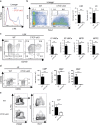CCCTC-binding factor is essential to the maintenance and quiescence of hematopoietic stem cells in mice
- PMID: 28857086
- PMCID: PMC5579513
- DOI: 10.1038/emm.2017.124
CCCTC-binding factor is essential to the maintenance and quiescence of hematopoietic stem cells in mice
Abstract
Hematopoiesis involves a series of lineage differentiation programs initiated in hematopoietic stem cells (HSCs) found in bone marrow (BM). To ensure lifelong hematopoiesis, various molecular mechanisms are needed to maintain the HSC pool. CCCTC-binding factor (CTCF) is a DNA-binding, zinc-finger protein that regulates the expression of its target gene by organizing higher order chromatin structures. Currently, the role of CTCF in controlling HSC homeostasis is unknown. Using a tamoxifen-inducible CTCF conditional knockout mouse system, we aimed to determine whether CTCF regulates the homeostatic maintenance of HSCs. In adult mice, acute systemic CTCF ablation led to severe BM failure and the rapid shrinkage of multiple c-Kithi progenitor populations, including Sca-1+ HSCs. Similarly, hematopoietic system-confined CTCF depletion caused an acute loss of HSCs and highly increased mortality. Mixed BM chimeras reconstituted with supporting BM demonstrated that CTCF deficiency-mediated HSC depletion has both cell-extrinsic and cell-intrinsic effects. Although c-Kithi myeloid progenitor cell populations were severely reduced after ablating Ctcf, c-Kitint common lymphoid progenitors and their progenies were less affected by the lack of CTCF. Whole-transcriptome microarray and cell cycle analyses indicated that CTCF deficiency results in the enhanced expression of the cell cycle-promoting program, and that CTCF-depleted HSCs express higher levels of reactive oxygen species (ROS). Importantly, in vivo treatment with an antioxidant partially rescued c-Kithi cell populations and their quiescence. Altogether, our results suggest that CTCF is indispensable for maintaining adult HSC pools, likely by regulating ROS-dependent HSC quiescence.
Conflict of interest statement
The authors declare no conflict of interest.
Figures








Similar articles
-
Adiponectin Enhances Quiescence Exit of Murine Hematopoietic Stem Cells and Hematopoietic Recovery Through mTORC1 Potentiation.Stem Cells. 2017 Jul;35(7):1835-1848. doi: 10.1002/stem.2640. Epub 2017 May 23. Stem Cells. 2017. PMID: 28480607
-
Fak depletion in both hematopoietic and nonhematopoietic niche cells leads to hematopoietic stem cell expansion.Exp Hematol. 2012 Apr;40(4):307-17.e3. doi: 10.1016/j.exphem.2011.11.010. Epub 2011 Dec 8. Exp Hematol. 2012. PMID: 22155722 Free PMC article.
-
AKT1 and AKT2 maintain hematopoietic stem cell function by regulating reactive oxygen species.Blood. 2010 May 20;115(20):4030-8. doi: 10.1182/blood-2009-09-241000. Epub 2010 Mar 30. Blood. 2010. PMID: 20354168 Free PMC article.
-
Reactive Oxygen Species and Nrf2: Functional and Transcriptional Regulators of Hematopoiesis.Oxid Med Cell Longev. 2019 Nov 18;2019:5153268. doi: 10.1155/2019/5153268. eCollection 2019. Oxid Med Cell Longev. 2019. PMID: 31827678 Free PMC article. Review.
-
Ex vivo HSC expansion challenges the paradigm of unidirectional human hematopoiesis.Ann N Y Acad Sci. 2020 Apr;1466(1):39-50. doi: 10.1111/nyas.14133. Epub 2019 Jun 14. Ann N Y Acad Sci. 2020. PMID: 31199002 Free PMC article. Review.
Cited by
-
Role of reactive oxygen species in regulating 27-hydroxycholesterol-induced apoptosis of hematopoietic progenitor cells and myeloid cell lines.Cell Death Dis. 2022 Oct 31;13(10):916. doi: 10.1038/s41419-022-05360-0. Cell Death Dis. 2022. PMID: 36316327 Free PMC article.
-
Chromatin accessibility and cell cycle progression are controlled by the HDAC-associated Sin3B protein in murine hematopoietic stem cells.Epigenetics Chromatin. 2024 Jan 23;17(1):2. doi: 10.1186/s13072-024-00526-w. Epigenetics Chromatin. 2024. PMID: 38254205 Free PMC article.
-
Transcriptional activation of regenerative hematopoiesis via microenvironmental sensing.Nat Immunol. 2025 Mar;26(3):378-390. doi: 10.1038/s41590-025-02087-w. Epub 2025 Feb 25. Nat Immunol. 2025. PMID: 40000903
-
Advances in molecular characterization of myeloid proliferations associated with Down syndrome.Front Genet. 2022 Aug 10;13:891214. doi: 10.3389/fgene.2022.891214. eCollection 2022. Front Genet. 2022. PMID: 36035173 Free PMC article. Review.
-
The Dual Role of ROS in Hematological Malignancies: Stem Cell Protection and Cancer Cell Metastasis.Stem Cell Rev Rep. 2020 Apr;16(2):262-275. doi: 10.1007/s12015-019-09949-5. Stem Cell Rev Rep. 2020. PMID: 31912368 Review.
References
-
- Wilson A, Trumpp A. Bone-marrow haematopoietic-stem-cell niches. Nat Rev Immunol 2006; 6: 93–106. - PubMed
-
- Wilson NK, Foster SD, Wang X, Knezevic K, Schutte J, Kaimakis P et al. Combinatorial transcriptional control in blood stem/progenitor cells: genome-wide analysis of ten major transcriptional regulators. Cell Stem Cell 2010; 7: 532–544. - PubMed
-
- Bigas A, Espinosa L. Hematopoietic stem cells: to be or Notch to be. Blood 2012; 119: 3226–3235. - PubMed
-
- Bigas A, Guiu J, Gama-Norton L. Notch and Wnt signaling in the emergence of hematopoietic stem cells. Blood Cells Mol Dis 2013; 51: 264–270. - PubMed
Publication types
MeSH terms
Substances
LinkOut - more resources
Full Text Sources
Other Literature Sources
Medical
Molecular Biology Databases
Research Materials

